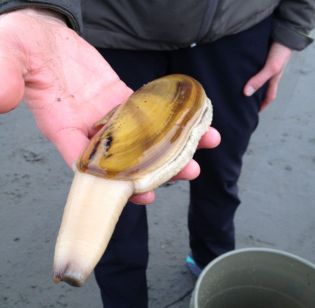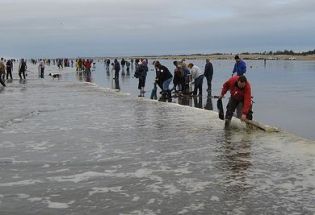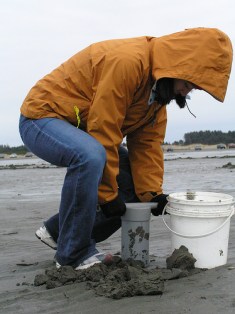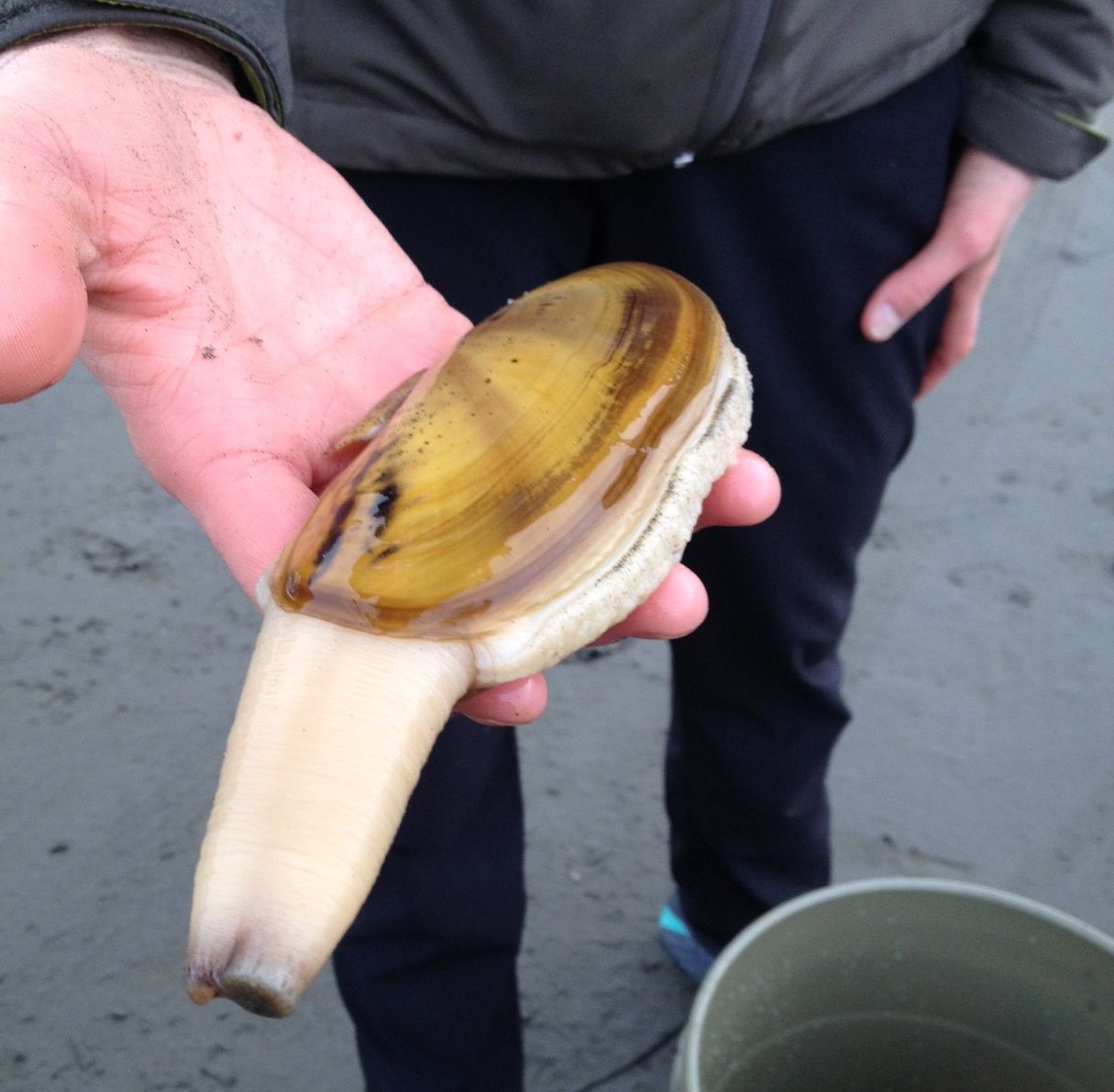
The elusive Pacific razor clam, in all its glory. (Photo by Ted Alvarez.)
You know what would make supermarket food taste better? Making grocery shopping more like clam digging. Imagine having to paw through a bin of wet sand to find your onions, or thrash through icy waves for a chunk of Parmesan. Challenging, yes, but think of the feeling of accomplishment as you sit down to dinner.
I thought about this last Sunday as I stood knee-deep in the Pacific, wind-whipped and sandblasted. I’d come to Washington’s Roosevelt Beach on the second clam-harvest weekend of the year to up my foraging game: Having already tackled blackberries, mushrooms, and dumpster donuts, the coveted Pacific razor clam seemed the logical upgrade. The animal kingdom is a whole new ball game, even if the animal in question does look kind of like a stray pancreas.
My boyfriend, Ted, and I had done our homework. We knew all about the clam show — a dime-sized dimple in the sand that’s as good as a neon arrow screaming, “Clam! Get your razor clam here!” We’d read tutorials and watched YouTube videos in which rugged hosts demonstrated digging technique, casually unearthing clam after clam.
Armed with a new clam shovel (basically, a long-handed trowel with a canted blade), a bucket, and a $19 season license, we cockily strode out on the beach as the tide receded.
“Ready to meet your meat?” Ted asked.
Pacific razor clams — six-inch-long beach dwellers found along the coast from California to Alaska — are one of the more sustainable protein options out there. Farmed clams of all stripes earn a Best Choice rating from the Monterey Bay Aquarium Seafood Watch. And wild clam harvests, like the one we were going to partake in, are carefully managed by state fish and wildlife authorities; because the clams are individually caught using simple tools, harvesting them has minimal impact on the environment.
And don’t forget the appeal of local, totally unprocessed food that you earn with the sweat of your brow. Diggers can savor these high-protein, low-fat, vitamin A-, B-, and C-packed morsels with minimal qualms. That is, if they can catch ’em.

Open season on clams, Washington state. (Photo by Mike Murry.)
A block-party vibe waited at the water’s edge. Hundreds of other diggers lined the surf in both directions. Hipsters in flowered galoshes hunted side-by-side with guys in waders and waterproof camo; little kids splashed through the waves; one old couple sat in the surf in lawn chairs.
It was all very encouraging: Pre-dig, I’d wondered if clammers were as notoriously tight-lipped and competitive about their favorite stashes as backcountry skiers and mushroom hunters tend to be. Would we be elbowed aside as longtime clammers defended their territory? Would the harvest devolve into a Hunger Games-style free-for-all, with diggers bludgeoning each other with shovels to get at the precious bivalves?
I shouldn’t have worried. Too few beaches are open to digging, and harvest limits are too small (15 clams per licensed digger) for anyone to get possessive. Besides, when you’re all sloshing around in February ocean water with your arms shoulder-deep in the sand, you can’t help but feel the camaraderie.
This was a lucky break for us, as our clam feast would’ve been a nonstarter without a little help from our friends.
Turns out, digging a razor clam is damn near impossible with a mere shovel, at least for a neophyte. The little buggers flee deeper into the sand much too quickly for that.
For the first 30 minutes, Ted and I played out a ridiculous routine: See the telltale dimple. Dig frantically on the seaward side of the dimple. Drop to our knees and plunge our bare arms into the cold, wet pit. Root around, occasionally just grazing the tip of the clam’s neck, until a wave inevitably crashed over the pit and soaked our pants.
“Maybe we just need more practice,” I said after my fifth or sixth attack failed.
“Maybe this just sucks,” said Ted.
That’s how it would have gone all afternoon if not for the intervention of a bona fide clam angel. His name was Kenny VanEtten, and he started by pointing out a show for us to dig. “I’ve already got my take,” Kenny told us cheerfully. “This is so much fun, I just don’t want to go home yet.”

Hoover clam: demonstrating the proper use of a clam gun. (Photo by Laurel Fan.)
After watching a few more of our slapstick attempts, he gently offered us the use of his clam gun.
Yes, clam gun.
You see, there are two ways to dig a clam: the old-school clam shovel and the fancier clam gun. Resembling a jackhammer made of PVC, the “gun” works through brute force and suction to pull the clam to the surface. (What, you were hoping for tiny mollusk bullets?)
Guided by Kenny’s 5-year-old daughter, Makena, who was an excellent clam scout, and armed with the gun, our prospects went from bleak to red-hot. Suddenly, clams seemed to be everywhere. We’d plunge the gun over the show (tilted ever so slightly seaward), twisting to help it slide deeper into the sand, then cover the small hole on the top with our thumbs to create suction. Next, we’d wrestle the gun back up and dump its column of sand. Almost every time, a juicy razor clam tumbled out with it.
All around us, our neighbors rode the same groove. People called out to their fellow diggers whenever they found a pocket of clams, creating mini-gunning parties full of cheering and attaboys.
We hit our 15 all too quickly. What a strange and wonderful experience, this communal enthusiasm about food — it gives off the same sort of buzz you find around neighborhood gardens, homebrewing classes, and county fair bake-offs. Anytime people gather to put a little extra effort into what they consume, that warm and fuzzy feeling follows.
When’s the last time you got that from buying tortilla chips?
We thanked Kenny the clam angel and reluctantly turned our backs on the sea. Just as well. My waterproof boots, long ago swamped by the surf, had gone squishy with seawater, and my hands were frozen into clam-scented claws. We carefully braced the bucket in our backseat; the clams floated serenely inside, seemingly resigned to their fate.
With the thrill of the hunt fading, Ted and I looked at this bounty of fresh clam, then at each other. Now came the hard part: figuring out what to do with these little delicacies.
Next time: How 15 fresh razor clams took over my kitchen, and the clam hangover that followed.




